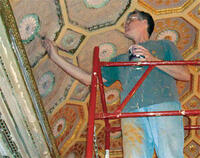HABITAT
Lobby Restoration
A lobby makeover has the power to arouse passionate feelings about everything from financial priorities to aesthetic sensibilities. Just ask the board that runs the 80-unit co-op at 260 West End Avenue on Manhattan's Upper West Side, where an elaborate restoration tells the tortuous story of how this project went from dream to reality — holding lessons for every co-op or condo board considering a makeover of any public space in the building. Such projects affect every resident. The stakes are high, the perils numerous, and the outcomes can range from traumatic to triumphant.
When this building by the prolific architectural firm of Schwartz and Gross opened at West End Avenue and West 72nd Street in the mid-1920s, the small foyer and larger lobby were a magnificent confection of bronze doors with leaded-glass windows, bronze railings, terrazzo floors, vaulted ceilings, marble casings and travertine stairways. Mae West is said to have been one of the building's many celebrity residents. But after decades of neglect and deferred maintenance, the once-ravishing foyer and lobby had turned dim and musty. (Click on image below to enlarge)
Then in 1997, Lois Meredith moved into the co-op.
"The lobby has been a project of mine that started practically the moment I first walked into the building," says Meredith, a clinical psychologist and playwright who has served on the co-op's board since 1998 and is now chairman of its seven-member lobby committee.
But her dream of restoring the building's "precious artifact" to its original glory ran into a pair of common obstacles: a lack of money and the reluctance among shareholders, particularly longtime residents, to make costly changes that they saw as cosmetic and unwise.
"This co-op runs close to the bone financially," Meredith says. "We have a very small reserve fund. We tried several times to pass a flip tax, but it hasn't happened. Then, about five years ago, a group of us said, 'To hell with it, we're going to do some research just to see what the cost would be.'"
Meredith persuaded the board in December 2006 to let her form a committee to study what it would cost to do a complete restoration. She chose five fellow shareholders whose taste and judgment she respected — an attorney, an author, an interior decorator, a retired school administrator and a TV writer — and the group went to work. The committee later added an architect.
While the building, managed by Midboro Management, is not landmarked, it is historic, and so the group interviewed and sought proposals from five sets of architects, general contractors and others who were known for restoring landmarks. The estimate came to around $250,000. The committee chose Manhattan architect Mark A. Irizarry, who'd impressed them with his 28 years in the business and his long working relationship with numerous skilled craftsmen, including stone restorers, metalworkers and plasterers. The full board and the committee interviewed him in August 2007, recounts Meredith (below, in her one-woman show Faces of a Woman) , "and the board told us to go for it."
Convincing Shareholders
One hurdle remained: selling shareholders on the idea that a quarter-million-dollar lobby restoration would enhance the value of their apartments and be worth the bank loan and special assessment needed to finance it. At the annual meeting in October 2007, a standing-room-only crowd materialized to discuss this hot-button issue.
"There was a lot of back and forth," recalls Brian Hargrove, a TV writer who was elected board treasurer that night and also serves on the lobby committee. "But eventually the majority of shareholders agreed that it was the right thing to do. …[I]f your front porch is falling down, you fix it."
The co-op took a bridge loan to cover the restoration's cost. When the project is complete, says board president Cynthia Walsh. they'll tally the cost and have a special assessment to repay the loan. One board member estimates that when the project is finished, an assessment of about $5,000 will be levied on her two-bedroom apartment.
Work started in February 2008, when an architectural sculptor began repairing the elaborate plaster moldings on the ceiling trim. Next came Manhattan-based decorative painter Ron Sharpe (seen painting the ceiling in the opening photo, at top), who has worked with Irizarry for 20 years. He was shocked by the lobby's condition. "It looked like an ashtray," Sharpe says. "It was incredibly black. Dust and fuzz were hanging from the vaulted ceiling like stalactites, and the old paint fell off like potato chips."
Since the goal was not to renovate the lobby but to restore it, as closely as possible, to its original condition, research was required as to the ceiling's colors. Committee members visited the nearby Apple Bank on Broadway, also built in the mid-1920s, to get ideas. Sharpe added suggestions.
The committee hammered out such aesthetic decisions, while the full board made all financial decisions. "I'd say our committee has been largely harmonious, but there have been passionate outbursts," Meredith says. Concurs Miller, "We've had some very lively discussions: Which gold should we use here? Why do you like a different color there? But it makes life easier if there are only seven members on the committee. If all 73 families [in the co-op] were involved, you could get 73 different opinions. Some of the committee's votes were unanimous, some were not. You win some, you lose some."
And sometimes, despite all your planning, you find yourself facing the unforeseen.






